Catholic Truth Society – Vintage Values book & exhibition
November 6, 2013
 The Young Lady says “NO”!, Rev. Wm. P. O’Keeffe C.M., Catholic Truth Society of Ireland (1946). Cover design: John Henry. Courtesy of Veritas/Vintage Values.
The Young Lady says “NO”!, Rev. Wm. P. O’Keeffe C.M., Catholic Truth Society of Ireland (1946). Cover design: John Henry. Courtesy of Veritas/Vintage Values.

What to do on a Date?, Rev. Daniel A. Lord S.J., Catholic Truth Society of Ireland (1958). Cover design: Martin Collins. Courtesy of Veritas/Vintage Values.

Fashionable Sin, Rev. Daniel A. Lord S.J., Catholic Truth Society of Ireland (1957). Cover design: Martin Collins. Courtesy of Veritas/Vintage Values.

Divorce is a Disease, Rev. Martin J. Scott S.J., Catholic Truth Society of Ireland (1944). Cover design: John Henry. Courtesy of Veritas/Vintage Values.

Suggestions om saying the Rosary Without Distractions, Sister M. Emmanuel O.S.B., Catholic Truth Society of Ireland (1944). Cover design: John Henry. Courtesy of Veritas/Vintage Values.

A Guide to Fortune Telling, Rev. Daniel A. Lord S.J., Catholic Truth Society of Ireland (1943). Cover design: Sean Best. Courtesy of Veritas/Vintage Values.
Earlier this year I wrote about the cover art of Catholic Truth Society of Ireland pamphlets. At the time I had very little in the way of facts to go on and the piece was essentially guess work. Shortly after writing the post I was contacted by Lir Mac Cárthaigh, Art Director at Veritas, who informed me that they hold a full archive of the pamphlet covers and have details of the cover artists behind each of the designs! He told me that my conjecture about the artwork was correct and that they were in fact all designed by Irish designers. Also, the pamphlets were reprinted many times over the years so the reprint dates were often many years later than the original artwork was completed. Lir understood the importance of the archive and had been working for some time to bring it back to public view. He invited me to meet with him and view the collection, which I was delighted to do.
The archive consists of a couple of large filing cabinets which are jam-packed with dusty envelopes, each containing an original CTS pamphlet and a card detailing the cover artist, fee paid, print-run and subsequent reprints. The collection is so vast that it was only possible to view a small random sampling of the covers. The earlier covers, from before the 1920s, have generic typographic covers but designs from the twenties on incorporate illustration and as you move through the years the artwork gets more and more bright and vibrant.
While the archive contains work by artists who are reasonably well known, including George Monks, Karl Uhlemann, Ailbhe Ó Monacháin (Alfred Monahan) and numerous examples by George Altendorf, I was most excited by the work of a number of complete unknowns – John Henry, Martin Collins and Sean Best. These three artists worked in a style heavily influenced by advertising spot illustration and showcard art. Their work displays a confidence and skill which really makes it sparkle. For a long time this sort of design was dismissed as low-brow or purely vernacular but in more recent times there has been a growing appreciation of the craft involved in making this work.
Unfortunately, we have scant details of these three artists. John Henry was a student at the Dublin Metropolitan School of Art in the early 1920s and would have studied along side George Altendorf under Austin Molloy. Seán Best designed the cover of the official Eucharistic Congress programme (1932). A Martin Collins held a solo exhibition of paintings in Lad Lane Gallery in 1978 and was also working as a ‘visualiser’ with the Peter Owens advertising agency in the early 1980s but it’s impossible to say if either or both are the same artist who created these pamphlet covers.
Since our meeting, Lir Mac Cárthaigh has been busy sifting through the archive and assembling a book and exhibition which showcase some of the most interesting examples from the collection. The exhibition, entitled Vintage Values, runs at the National Print Museum from the 4th until the 24th November and the Vintage Values book, which I had the pleasure of writing the introduction for, will be launched on the 19th of November at the Print Museum. A number of poster prints and postcards of the designs are available from the Vintage Values website.
Little Magazines: Literary Periodicals 1950 – 1970
July 10, 2013
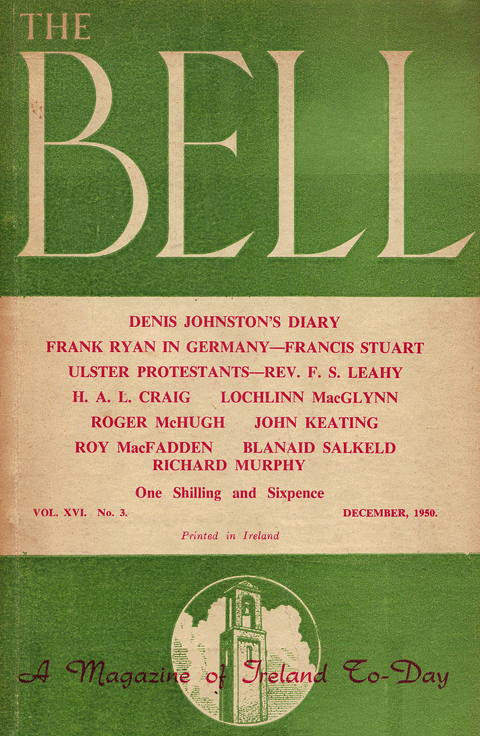
The Bell, Vol. XVI No. 3, December 1950. Design: uncredited
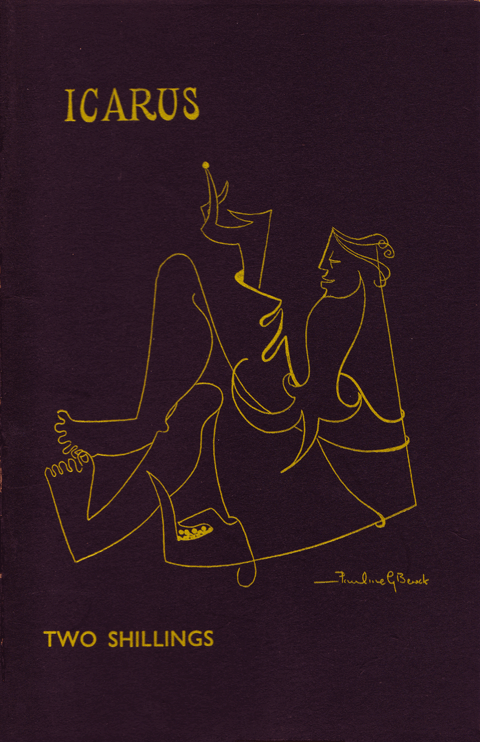 Icarus, Vol. 5 No. 17, November 1955. Design: Pauline Bewick
Icarus, Vol. 5 No. 17, November 1955. Design: Pauline Bewick
 The Kilkenny Magazine, No. 2, Autumn 1960. Design: Christopher Fay
The Kilkenny Magazine, No. 2, Autumn 1960. Design: Christopher Fay
 Poetry Ireland, No. 1, Autumn 1962. Design: uncredited (Ruth Brandt)
Poetry Ireland, No. 1, Autumn 1962. Design: uncredited (Ruth Brandt)
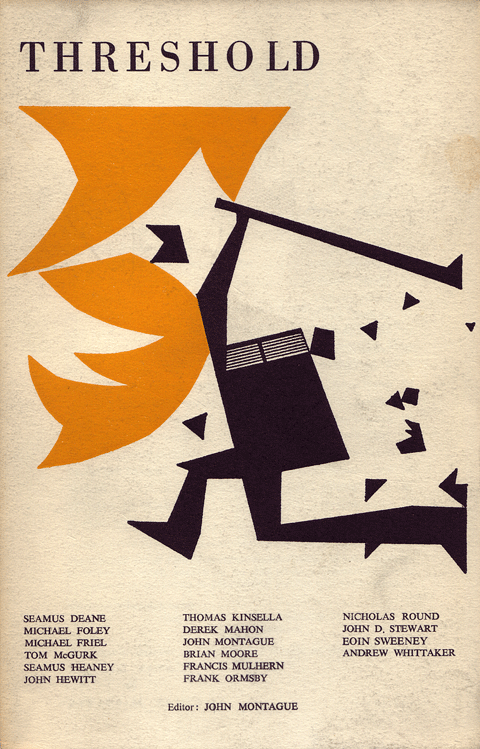 Threshold, No. 23, Summer 1970. Design: Colin Middleton
Threshold, No. 23, Summer 1970. Design: Colin Middleton
Literary magazines held a special place in the cultural life of mid-century Ireland. Although print-runs were low, their impact was disproportionate and they managed to reflect a more varied and complex Ireland then the mainstream media. The five examples above all follow a set format – octavo in size, each has a mono interior with a 2-colour cover on heavy uncoated card.
The Bell is the best know of the magazines here. The first issue appeared in 1940 under the editorship of Seán Ó Faoláin. It managed to continue publication throughout the ’40s, challenging the then dominant, and restrictive, notion of Irishness. The above cover from 1950 bears more then a passing resemblance to the classic Penguin covers of the period. The magazine ceased publication in 1954.
Icarus is a literary magazine published by Trinity College, Dublin. It was founded in 1950 and I believe it is still extant despite a very low profile. Iain Sinclair, Hackney historian and psycho-geographer, served as editor in the mid-sixties when he attended TCD. The arresting cover featured here is an early commercial commission by Pauline Bewick. Some simple but very effective spot illustrations in scraper-board, also by Bewick, appear in the interior. The cover art has generally moved with the times but hasn’t always been as successful as this example. Tim Booth of Dr Strangely Strange fame delivered a comic book inspired cover in 1965 and Tom Doorley, food critic, supplied a decent design for the Trinity Term 1982 issue.
The Kilkenny Magazine lasted 18 issues from 1960 to 1970. Issue no. 2, Autumn 1960 (above) includes a linocut by Christopher Fay on the cover. I can find no further artistic endeavors by the elusive Fay. The Spring 1963 issue included the first publication of Seamus Heaney’s Mid-Term Break.
Poetry Ireland has appeared in a number of different formats since it’s initial publication under founding editor David Marcus in 1948. This original iteration lasted 19 issues until 1952. For a few more years it ran as a supplement to Irish Writing, petering out in 1955. In 1962 it was resurrected as a magazine in its own right under the editorship of John Jordan. This new version lasted 8 issues until 1968 and was printed and published by the Dolmen Press.
The cover above is the first one under Dolmen’s watchful eye and is a triumph of earthy elegance, combining the unsophisticated beauty of letterpress with refined and understated layout and typography. The “fabulous bird”, as John Jordan referred to it, is the work of Ruth Brandt (1936-89). Brandt was the daughter of Muriel Brandt and married fellow artist Michael Kane in 1961. She provided illustrations and lettering for a number of Dolmen books but I can’t tell if she is responsible for the wonderfully blocky and not quite uncial lettering of the Poetry Ireland masthead.
Threshold was a publication of Belfast’s Lyric Players Theater. The first issue emerged in 1957 with Mary O’Malley as editor and it continued irregularly until 1990. The example shown is the 1970 “Northern Crisis” issue and sports striking cover art by Colin Middleton (1910-83).
It is probably no surprise that literary magazines looked to artists rather than designers for their cover art. There is certainly a discernible aesthetic sensibility running through these disparate publications.
Pulp fiction Irish style
June 20, 2011
 The Book of Famous Irish Spy Stories, Daniel O’Keeffe, Irish Pocket Books (1956). Design: M.G. (Michael Gallivan)
The Book of Famous Irish Spy Stories, Daniel O’Keeffe, Irish Pocket Books (1956). Design: M.G. (Michael Gallivan)
 The Book of Famous Irish Ghost Stories, Edited by Daniel O’Keeffe, Irish Pocket Books (c. 1956). Design: Michael Gallivan. (Courtesy of Larry Hynes)
The Book of Famous Irish Ghost Stories, Edited by Daniel O’Keeffe, Irish Pocket Books (c. 1956). Design: Michael Gallivan. (Courtesy of Larry Hynes)
 Memorable Irish Trials, Kenneth E.L. Deale, Irish Pocket Books (c. 1956). Design: Osborne. (Courtesy of Larry Hynes)
Memorable Irish Trials, Kenneth E.L. Deale, Irish Pocket Books (c. 1956). Design: Osborne. (Courtesy of Larry Hynes)
 Valentine Vaughan Omnibus, R. Thurston Hopkins, Grafton (1947). Design: unknown
Valentine Vaughan Omnibus, R. Thurston Hopkins, Grafton (1947). Design: unknown
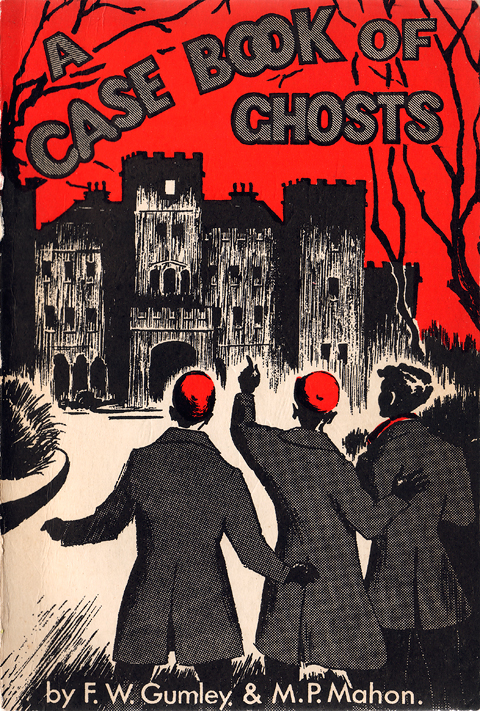 A Case Book of Ghosts, F.W. Gumley & M.P. Mahon, Northern Whig (1971). Design: unknown
A Case Book of Ghosts, F.W. Gumley & M.P. Mahon, Northern Whig (1971). Design: unknown
 Triúr don Chómgargadh, Eoghan Ó Grádaigh, Sáirséal 7 Dill Scéalta Mistéir Uimhir 5 (1968). Design: Úna Ní MhaoilEoin
Triúr don Chómgargadh, Eoghan Ó Grádaigh, Sáirséal 7 Dill Scéalta Mistéir Uimhir 5 (1968). Design: Úna Ní MhaoilEoin
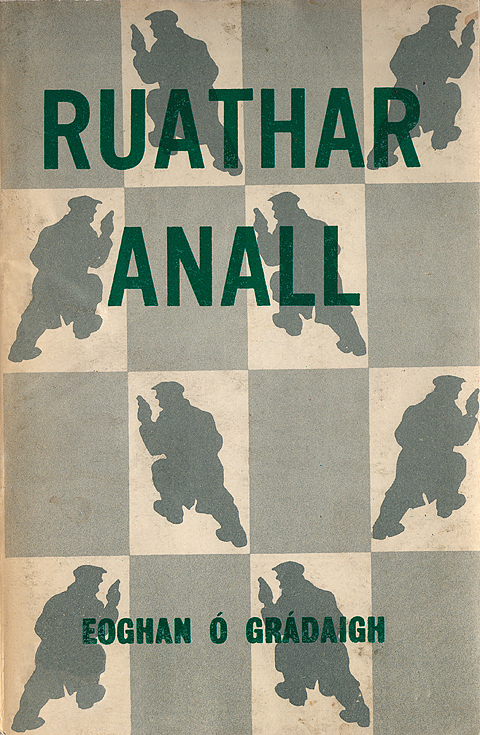
Ruathar Anall, Eoghan Ó Grádaigh, Sáirséal 7 Dill Scéalta Mistéir Uimhir 3 (1962). Design: Seoirse Mac Aodhagáin
Genre fiction has never really taken hold with Irish publishers. The zealous censorship of publications during the first few decades of the State probably played a role but it is more likely that there just isn’t a big enough population to sustain indigenous mass market paperbacks. The above examples of crime, mystery and horror covers display a charming amateurishness.
The first three are from The Mercier Press’ Irish Pocket Books imprint which operated in the mid-fifties. Michael Gallivan illustrated the first two and the third is by a mysterious ‘Osborne’. I’m afraid I can find no information on either artist. Larry Hynes kindly provided two of the examples which he included in a beautiful poster design celebrating 21 years of Charlie Byrne’s book shop in Galway.
There are 24 years between the next two examples, 1947’s Valentine Vaughan Omnibus and A Case Book of Ghosts from 1971, although the latter cover could easily be from the same period. Unfortunately, I don’t own a copy of the Valentine Vaughan book. The October 2010 issue of Book and Magazine Collector, from which the image is taken, estimates it’s value at £150-£200 sterling! The book is set in London but was published in Dublin by Grafton.
The final two covers are from Sáirséal agus Dill’s Scéalta Mistéir (Mystery Stories) series from the sixties. Úna Ní MhaoilEoin presents a rather naive rendering of a smoking pistol on the fifth book in the run, Triúr don Chómgargadh. I previously posted another of her designs for the series, An Masc. Ní MhaoilEoin wrote and illustrated a number of travel books for Sáirséal agus Dill during the sixties including An Maith Leat Spaigiti? (Do You Like Spaghetti?) (1965) and Turas Go Tuinis (Trip to Tunisia) (1969). According to Manchán Magan the Sunday Dispatch described her books as the most amusingly outspoken books ever to have appeared in the Gaelic language.
Cló Morainn Covers
August 16, 2010
Lá Dá Bhfaca Thú, Críostóir Ó Floinn, Cló Morainn, 1955. Design: Mícheál Ó Nualláin
Ag Baint Fraochán, Séamus Ó Néill, Cló Morainn, n.d. (1956). Design: Mícheál Ó Nualláin
John Devoy, Séan Ó Lúing, Cló Morainn, 1961. Design: uncredited
I believe that Cló Morainn started publishing in 1955. It is mentioned as a new venture in a review of Críostóir Ó Floinn’s Glaotar na Ridiri in The Irish Times of April 26, 1955. Sharing the page with the book reviews is Cruiskeen Lawn by Myles na Gopaleen (Brian Ó Nualláin) which seems appropriate as two of the Cló Morainn covers above were designed by Ó Nualláin’s brother – Mícheál Ó Nualláin.
These covers have a very modern feel and eschew illustration, relying instead on typography and bold blocks of colour. Lá Dá Bhfaca Thú is particularly effective. Mícheál Ó Nualláin is an accomplished painter yet I hadn’t realise that he had also designed book covers until I stumbled on these examples.







